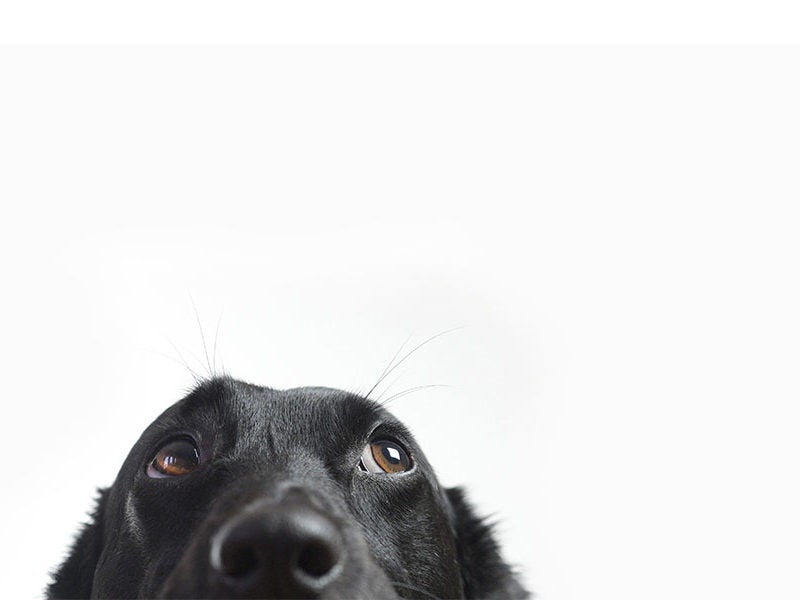
I’ll bet if you asked most people “Which animal do you commonly associate with bad luck?” a frequent response you’ll get is “a cat.” Legend has it that if your path is crossed by a black cat, that is a sign of misfortune. In folklore, witches often take the form of black cats while carrying out their nefarious schemes against people. But there is a long tradition that has likewise associated dogs with luck, both bad and good.
I once had a wonderful Flat-Coated Retriever named Odin. His coat was a shimmering black, with no white on any place on his body. Friendly, bouncy, and sociable were the best descriptions one could use for him.
Yet when I was walking him through the city, some people would cross the street to distance themselves from him, while others would step into storefronts to avoid him. I believe that this was not because of anything Odin had done but because at some subconscious level, there is a lingering association of large black dogs with devilish acts.
Throughout the British Isles there are stories about Black Shuck, a huge black dog with glowing red eyes who roams the countryside and is the very embodiment of the devil. To meet this black dog at night is a truly bad omen, and perhaps even a portent of death.
Islamic scholars tell of the time that the Governor of Medina came to the Prophet Mohammed. He was concerned about the number of stray dogs overrunning the city. These pariah dogs had become a major health issue because of the number of cases of rabies that they were responsible for. At first, Mohammed took the uncompromising position that all the dogs in the realms under his control should be exterminated and thus issued his command to kill all dogs. On reflection, however, the next day he retracted his decree. He did this for two major reasons. The first was religious, namely that dogs constituted a race of Allah’s creatures, and He who created the race should be the only one to dictate that it should be removed from the earth. The second was more pragmatic. The Prophet observed that some categories of dogs, particularly guard dogs, hunting dogs, and shepherd dogs, were useful to humans and had hence earned their right to exist. While Mohammed repealed the sentence of death for dogs who work and have useful functions, he allowed it to stand for one class of dogs—namely, stray, black dogs. The reason for this is that he believed the devil often appears masquerading as a black dog.
The idea that a black dog might be the devil probably accounts for the superstition in Ireland that says if a black dog visits the grave of a priest it means he had been untrue to his vows. Similarly, in Germany, I was told that a black Poodle visiting the grave of a woman meant she had committed adultery.
The tradition of the evil black dog carries on into modern times. Thus when the series of horror films The Omen (about the child of the devil) incorporated a storyline of dogs committing murder and mayhem, the dogs chosen for the roles were coal-black Rottweilers.
More recently, this superstition manifests in what animal shelter people call “Black Dog Syndrome,” implying that black dogs are the least likely to get new homes. They argue that this is perhaps because those negative superstitions hover at the back of the minds of people looking for a pet.
There seems to be some scientific support for their notions that black dogs are not viewed positively. In a study conducted in my laboratory, we had people rate photographs of dogs, including a set of Labrador Retrievers that differed only in color. We found that black Labs were rated 27 percent less friendly than yellow Labs, and that black dogs were twice as likely to be rated as being aggressive.
But as in all things associated with superstitions, the beliefs are not consistent. Throughout Eastern Asia, and particularly in Japan, the devil dogs are white. The touch of such a dog surely predicts the death of the person involved.
At my university, I have a colleague who is married to a businessman who immigrated here from Scotland. Apparently, in Scotland, there is a belief that if you see a dog with black and white spots or patches while you are on your way to a business meeting or negotiation, you are bound to be successful. She said her husband purchased a Harlequin Great Dane (a white dog with black splotches and spots) as their family dog. That was so that he would never leave for work without seeing this particular dog and thus—of course— pumping up his luck. As she explained to me, “Harley is a very large dog to share your living room with, but, who knows… My husband’s company is very successful.”
Originally published in AKC Family Dog.

